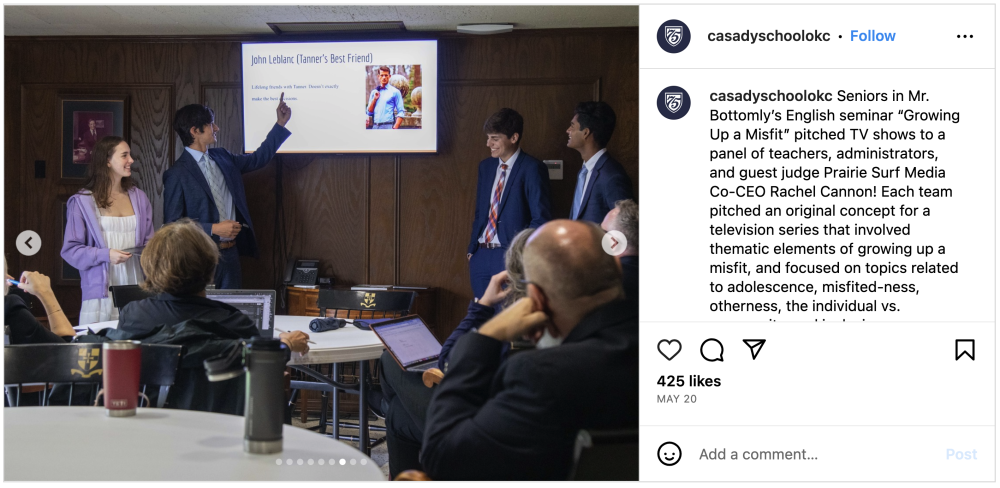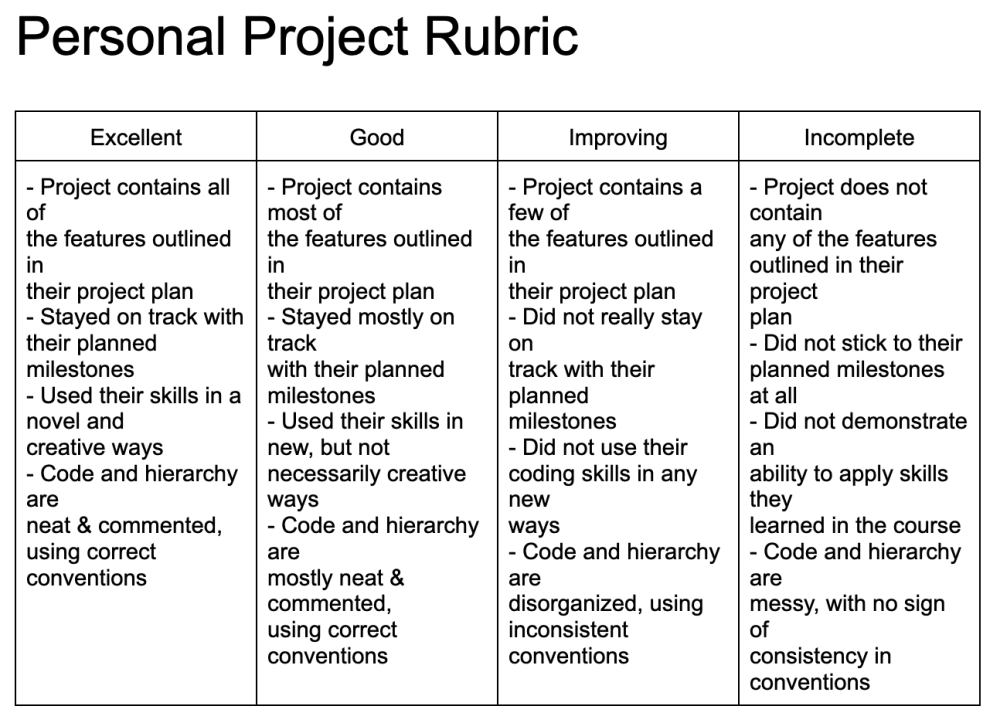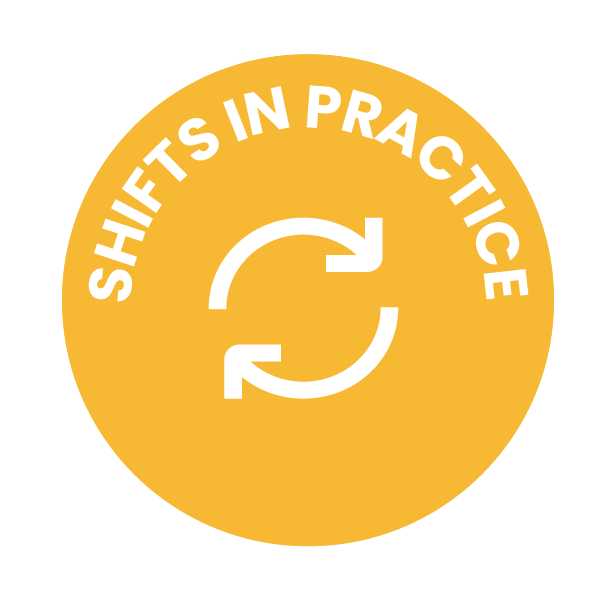Stories, Strategies, Student Products: Designing for Authentic Assessment
(Josh)
Today is the “big reveal”. The Clark-W-Griswold-drumroll moment.
I flash up on the Apple TV screen a picture of Rachel Cannon, Co-CEO of Prairie Surf Media.
“For your (alternative) final exam, you will present your final product to this local celebrity.”
That’s right. The actress on hit shows like Fresh Off the Boat and Mad Men now turned business partner with Frank Marshall and Steven Spielberg on the film Twisters, Universal Studios' big 2024 blockbuster release!
Eyes dilate the size of Titleist golf balls.
A senior immediately raises her hand, “And what is this product?”
“Great question,” I quip with a wry smile. “A TV show pitch.”
Our class has watched the first season of Reservation Dogs, focusing on topics related to maturity, misfitness, and belonging. Now it is their turn to create their own Netflix-like series.
The project will involve students signing a release form vetted by lawyers, as well as presenting in front of Casady’s communication team for social media.

Weeks later, my students are dressed in formal business attire, standing outside the Woolsey Board Room, antsy and jittery, each team waiting their turn to enter the musty smelling room to make their TV pitch. Greeting them is a blond-haired woman dressed in a black power suit, pen in hand, eager to engage.
All four pitches are unique and impress Rachel. In the end, one pitch stands above the rest.
The winner: a Marvel-like-alternate-universe-dystopian anime show entitled Atlas.
In the winning aftermath, Rachel invites “Team Atlas” to spend the summer with her team at Prairie Surf’s downtown studio to develop their nascent concept into a real pilot.
(Rob)
“That didn’t go well.”
The two sophomore students stare quizzically at the dry-erase top table in one of our regularly-scheduled progress meetings. They have built an iPhone app with a Firebase backend and a machine-learning model to help facilitate the complex process of carpooling in Casady School’s primary division. Now they are recounting their first big prototype meeting with their client.
I ask what exactly is said and they list the feedback they have received. It is a long list. They have taken notes. The feedback isn’t just tweaks, but instead, major redesigns. Features they have painstakingly developed will need to be abandoned. There are no sacred cows. New features will need to be built from the ground up. A common inflection point in the development of any product, so I ask the necessary question, “What next?”
At the start of the year, all students select a personal project to complete throughout the year. Sometimes this includes taking on clients like the primary division director. The personal project serves as the culminating assessment of the year, graded with a simple rubric.

During set aside time, throughout the year, students are thinking, designing, and creating. Always working toward an M.V.P. (Minimal Viable Product) to present at the end.
Going into that first prototype meeting, those two sophomores are confident, convinced they have completed their personal project in record time and wondering what they will be doing for the rest of the year.
After that first prototype meeting, those two sophomores have to look critically at their iPhone app, make some hard choices and significant changes. Ultimately, they are very successful.
They go on to win the congressional app challenge for the fifth district of Oklahoma, travel to DC and present their app in congress. None of which would have been possible without first answering the question, "What next?"
Authentic Assessment
When we talk about authentic assessment, we mean any assessment that involves real world application or simulation that requires students to transfer their skills and knowledge. The operative word being transference.
Over the years, when it comes to exploring authentic assessment, we have learned some valuable lessons through an undulation of successes and failures. To that end, we hope this kaleidoscope of messily earned strategies and suggestions provides you with some practical insight and inspiration to lean into authentic assessment regardless of your respective discipline.
Agency Above All (Josh). Student voice and choice matter. Brain science, cognitive psychology, and social science all support this thesis. The research out of Independent School Management (ISM) reveals that what students most value involves self-efficacy. Ask yourself then, do my assessments offer students multiple options and pathways to demonstrate mastery of skills and knowledge? Do I bake in choice and voice when it comes to texts, prompts, problem sets, modalities, partners, products, and even performance indicators? The key is that students feel the animating lifeforce of personal agency; an invitation, in other words, for the learning to be done by them instead of to them.
Start Small (Rob). Your school community is full of opportunities for developing solutions and it is easily accessible. Strategic collaborations throughout your community present places where students can see their work have meaningful impact. Having an older student build an app to help younger students learn to read is an excellent example. Being able to contribute to their local community really helps develop the motivation necessary to successfully complete a challenging project. Additionally, a school community will provide for easy access to supportive and learning-focused clients who can provide constructive feedback. A key to finding those opportunities is communicating across disciplines and divisions, advertising your programs openness to accepting challenges, broadcasting those projects you have already completed. One or two products can lead to a plethora of offers for clients.
Bias Action (Josh). To bias action is to embrace the mantra, “I think, therefore I do.” We shift from Descartes’ dictum to the Nike swoosh. From students as nouns to students as verbs. From tests to tasks. From assessment of learning. To assessment as learning. The best assessments push students to engage in real-world projects. They have to email adults. Make cold calls. Organize meetings. Create agendas. Set goals. Interview people. Facilitate conversation. Identify next steps. Follow up. Hit deadlines. Generate prototypes. Jump in the shark tank. Get chewed up a bit. Iterate. Iterate again. Present a solution. Produce results. In other words, hustle for real and get s%*t done.
Both/And (Rob). Too often the “tyranny of either/or” can inhibit greater personalization in the learning process. For example, a to-do list app is a lot less complex in the technologies and programming it requires, and yet the same application designing skills are applied to it that are applied in designing something like Smart Carpool, the carpool assisting app. Therefore I was able to assess the learning I was targeting through both apps, and, yet, each app provided a student with an opportunity to successfully accomplish their goal while also challenging them appropriately along the way. This both/and approach provides a way to meet each student where they are and gives them enough space to grow their other skills and abilities. Both/and helps ensure equity over equality. If two students build radically different products, but employ the same skills in the process, then they both can be assessed on those skills and yet have an experience that is unique to them. With some guidance, that experience can be tuned to meet their needs. The key, I believe, is in designing the assessment: be specific and rigid in the skills that must be employed, but be nimble and flexible in the form the product can take.
Provide Guardrails (Josh). One reading of Lord of the Flies will do it. Kids need adults! Part of our job as teachers is to guide from the side; the other part is to guard from the side. Students thrive in structure; they like to know what is and isn’t okay. “Clear is kind,” as Brene Brown says. Instructions, of course, help clarify student expectations; rubrics also help students backward design their learning experience. Finally, regular check-points with “micro deliverables” can bolster student confidence and galvanize momentum in the learning process.
Lighthouse not Life Raft (Rob). Authentic assessments are rife with opportunities for students to struggle and fail in part because they require students to travel paths that haven’t already been well traveled. A key to the practice of authentic assessment is to appreciate and even celebrate the process of student struggle. Our nature as teachers requires us to nurture, protect, and guide. Too frequently we find ourselves “protecting” students from their own intellectual peril. We should rather equip them with the tools to rescue themselves and provide guidance along the way. We too often play the life raft. A life raft saves a person who finds themselves in deep water without the means to survive. On the other hand, the lighthouse helps guide a perfectly capable ship through particularly treacherous conditions. We should strive to be the lighthouse.
Recruit a Real Audience (Josh). Real-world learning requires real-world audiences. This can look like presentations in front of live audiences. This might include a boardwalk, fair, or exhibition. At Casady, for example, we have an annual “Exposition of Learning '' for our American Design interdisciplinary course, where in the Fee Theater, all 11th grade students present solutions they collaborated on with local organizations in Oklahoma City. This can also look like recruiting an expert from the community. For me, I've found that each “big reveal” of the guest judge supplies the thunderbolt of gravitas. In fact, I once had a senior mutter under his breath, “S%*t just got real.” The key is to put someone else in front of your students.
Show and Story (Rob). Communication is a key factor to designing anything which moves education forward. Eric Hudson lists it among his five key strategies for designing the future of schools. With authentic assessments, students often do the best job communicating in their own words about their own work. Giving them those opportunities is key. It can be as simple as presenting to the class. Communication gets exponentially more impactful the larger the audience. Having students present to students outside their class, through official notes sent home, or in a recorded format shared community wide are all great options for sharing the story of your students’ journey through your assessment.
Celebrate the “B-Word” (Josh). I’ve found that the “f” word sends kids into their lizard brain of fight, flight, freeze, or fall apart-ness. Failure is simply not an option. No matter how many times I tell them stories of failure-to-success (i.e. Michael Jordan getting cut from his 9th grade basketball team is a personal favorite!), most kids just don’t buy what I’m selling. I’ve found the “b word” has far more resonance with kids. A student gets ghosted in an email. Conducts 50 cold calls and solicits nada. Suffers a Jaws-like bite of criticism. Stares back at a heartless headshake, No. These tough moments in the learning process offer students real opportunities to bounce back and bounce forward.
Over is Not Done (Rob). Authentic assessment produces products that can be assessed and graded in their state at any arbitrary deadline, but they are never finished. One of the best parts of this process is that it produces things which can be continuously iterated, improved, updated, and expanded. Products are a part of a student's educational journey beyond the confines of a single class and revisited in future classes by those same students, or adopted by future students. Stanford’s Solar Car projects is a perfect example of a project that can live beyond any specific cohort of students. On a smaller scale, the Pulse project that was started three years ago in an object-oriented programming class has already outlived the class.
Concentrate on Competencies (Josh and Rob). What we measure is what matters. Let us say that again: what we measure is what matters. Authentic assessments provide us the opportunity to anchor our learning targets to real-world competencies - single skills, observable, transferrable, transdisciplinary, and learner-centric. The metrics we use to measure mastery then should be as meaningful today as they will be for our students ten years from now. The good news is that we’re seeing the rising tide of consensus around those critical competencies. To name a handful of key contributors:

(Josh and Rob)
Both of us draw inspiration from Brene Brown’s seminal work on courage. We often recycle through Brene reciting the Man in the Arena speech. Many times the harshest critics are the ones in our own head. So often we preach risk-taking to our students, but are afraid to take our own risks for fear of perceived incompetence. To that end, we aspire to model for our students what it looks like to show up not knowing the outcome, embracing the discomfort, and moving forward into the messy unknown with a strong back, open mind, and wild heart. A key in all of this involves transparency and vulnerability, a willingness to own the fact with students, parents, and especially administrators, that part of learning on the bleeding edge of innovation is that there will be challenges, mistakes, and opportunities for iteration. That’s how real-world learning happens! In closing, we’ve found that most constituents understand and support our wobbly and plucky efforts to provide our students with a powerful form of durable learning through authentic assessment that prepares them with the skills and knowledge for their future success.
For more, see:
- An Introduction to Student Co-Designed Learning
- Why Competency-Based Learning?: A Primer on CBL for Families
- Engaging More Students, More Deeply

This post is part of our Shifts in Practice series, which features educator voices from GOA’s network and seeks to share practical strategies that create shifts in educator practice. Are you an educator interested in submitting an article for potential publication on our Insights blog? If so, please read Contribute Your Voice to Share Shifts in Practice and follow the directions. We look forward to featuring your voice, insights, and ideas.
GOA serves students, teachers, and leaders and is comprised of member schools from around the world, including independent, international, charter, and public schools. Learn more about Becoming a Member. Our professional learning opportunities are open to any educator or school team. Follow us on LinkedIn and Twitter. To stay up to date on GOA learning opportunities, sign up for our newsletter.

